The internet is abuzz with posts, videos, and articles about ChatGPT right now. This completely free artificial intelligence has been lorded by some as: a job killer, the best tool since the Excel spreadsheet, and the quickest and cheapest way to generate copy – and the crazy part is, they’re not all wrong. ChatGPT isn’t going anywhere, and it’s constantly improving, so we’ve gathered our best tips for using this new AI tool to create great content.
1. 5 Seconds to Summarise
ChatGPT’s key feature for us is its ability to take a page or more of information and boil it down to a single sentence, a series of bullet points, or a paragraph. If you’ve got an article that you want to reduce into three points for a social post, ChatGPT can do that. If you’ve got a paragraph of data you need organising into a table, ChatGPT can do that. If you’ve got a transcript of your last meeting and need a quick to-do list generated… you get the picture.
This is our personal favourite use for ChatGPT. A lot of copy we see companies write can use polysyllabic, industry-specific words that make it hard to understand. Well, now you can copy that into ChatGPT and translate it into more digestible language. It’s not always a perfect science and you might have to make your own corrections so use it carefully.
2. Artificial Intonation
If you think ChatGPT’s reply to your prompt is too formal, or not quite right for your target audience, you can ask for changes. This also works with your own copy; even if you think you’ve got the perfect tone of voice, running it through ChatGPT can give you another voice.
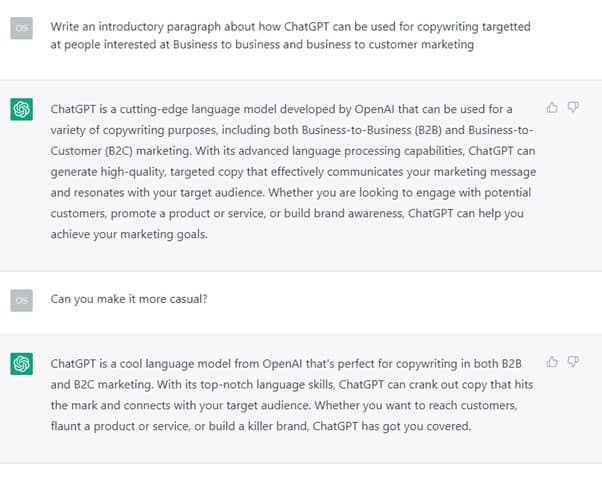
It isn’t just formal vs casual, you can specify various demographics, of course, like a lot of ChatGPT, it’s not an exact science, but there’s no harm in asking it to regenerate responses if you don’t think they work.
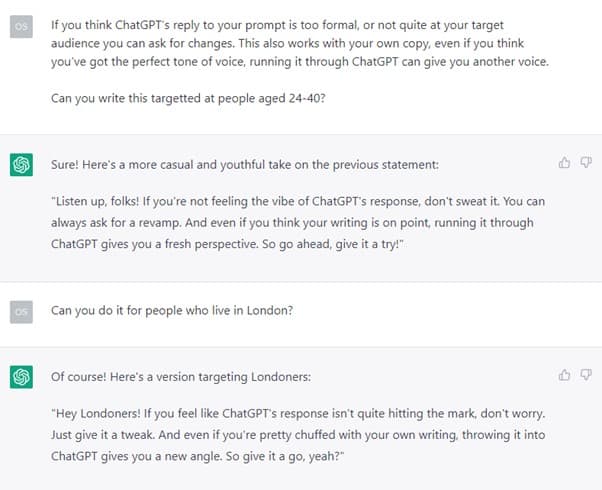
3. #Hashtags
Hashtags are so important on social media, they’re a great way of getting your content out to interested parties and finding a perfect balance between the right hashtags to get your brand noticed, and clogging up your post with a thousand and one tangentially related hashtags is so important to making the perfect post.
Guess what, ChatGPT can do it for you!
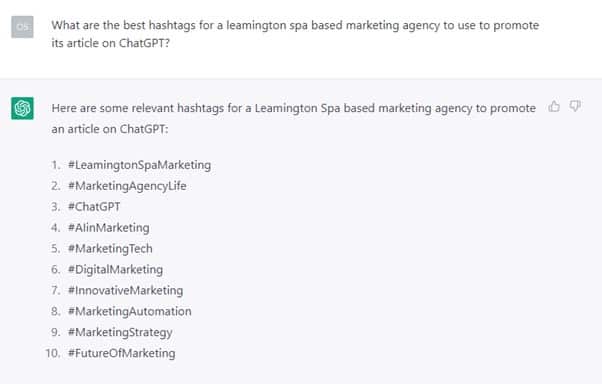
And like a lot of things ChatGPT can help with, if you’re not 100% satisfied with what it gives you, it’s still a great jumping off point for you to get ideas from.
4. What’s the word?
The English language is an unfriendly beast. Just that sentence alone could be said a hundred different ways. So, it’s understandable that finding the perfect words for something can be a struggle. We’ve all had that moment where we know a word exists, but you can’t quite put your finger on it.

This is the best use we’ve found for ChatGPT so far, but it also works with full sentences. If you can remember the definition of a word, but not the word itself all you have to do is type in the definition and it will give you the word, a lot quicker than google!
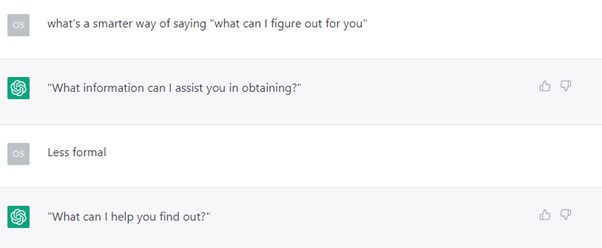
5. A second pair of (A)eyes
Not every company can sacrifice two or more copywriters on producing one bit of copy, let alone an editor to sign it off. After spending hours on one piece of writing, it can be a challenge to assess your own work and a second pair of eyes is so useful to reassessing what you’ve written.
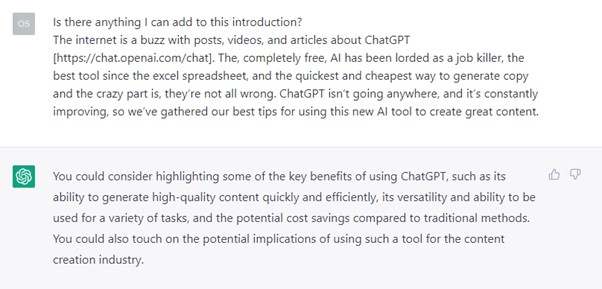
ChatGPT can give you ideas and angles you might not have considered, or point out how you should emphasise a specific topic.
6. SEO you later
For a lot of people, Search Engine Optimisation (SEO) is the white whale of marketing. It’s tricky to find a balance between copy that is readable to general audiences, and relevant to a search engine enough to put your website higher up the search than your competitors. ChatGPT’s strongest ability is being able to assess a text faster than any writer or editor. This means it can generate key words relating to your target audience or niche. It certainly won’t replace a fully trained SEO professional, but if you’re marketing on a budget, it’s the perfect solution.
You might be reading this blog thinking ChatGPT is the solution for all your content generation, but the AI certainly isn’t perfect. The biggest thing worth noting is what I mentioned before, it’s got no way of identifying truth from fiction, this can be remedied of course with a quick google search, but it’s always good to double check information before using something taken from ChatGPT.
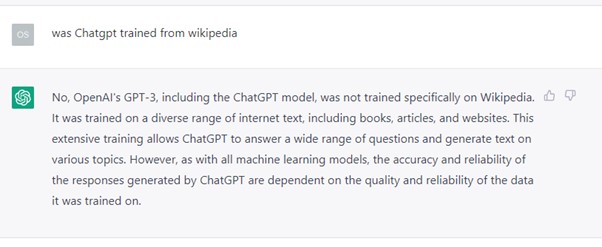
ChatGPT is built as a conversational AI first and foremost, it replies in ways that are readable but not always accurate. As with the above, in a text you might mix up ‘which’ and ‘that’ but when writing copy it can look unprofessional. We can’t recommend enough rereading whatever you write anyway, but especially if you’re copying directly from ChatGPT.

Finally, a big thing to watch out for is it’s old. As of writing this, all the information put into ChatGPT was taken prior to 2021. This means you can’t ask it to summarise the weeks news for you or explain the drama in the latest season of Love Island, it also means that the information it can give you might have changed or updated, another reason to always double check what you take from the AI.
So, is it the industry killer people seem to think it is? Not really. Think of it like this, google translate exists, but we still have translators, tractors exist but we still have farmers. ChatGPT is a fantastic tool that is improving by the minute, so give it a go and find out what it can do for you!
Earlier this week, Google announced a competitor to ChatGPT, Google Bard and we’re certain more companies will be releasing similar AI in the near future. It will be interesting to see where Google Bard differs from ChatGPT. Our hope is that its responses will be more accurate and up-to-date, but when it releases “in the coming weeks” you’ll get to be the decider on which one you use.
Regardless, ChatGPT’s biggest weakness is how often it hits capacity, hopefully a Google alternative will give more people a chance to use either creative AI tool.
Just to prove how useful ChatGPT can be, I copied in this article and asked it to generate a title for me:

